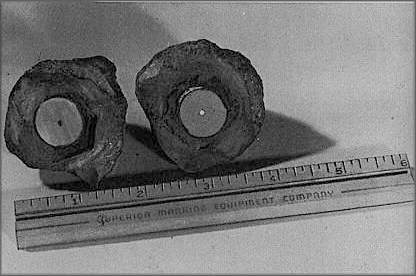%2C_Buursen%2C_the_Netherlands.jpg) |
| Star Jelly Bj.shoenmakers |
Star Jelly is a term used to describe a strange opaque
jelly-like substance that people have been claiming falls to Earth during
meteor showers for hundreds of years. The substance is apparently very real and
it does seem to fall from the sky, though there is not any concrete evidence of
this. It is weird enough, in and of itself, but some of the theories of its
origins and the lack of scientific knowledge regarding Star Jelly make the
substance even weirder.
Star Jelly is described as opaque or gray in color. It is
said to be like a gelatin mold. Mounds of star jelly that are up to several
feet in diameter or length have been discovered. Blobs of it have been found in
trees, on top of cars, on the ground and more. Scotland and the UK seem to be
popular sites for the dispersion of Star Jelly, though it has been found in Australia and the United States as well.
Scientists at the Macaulay Institute in the United Kingdom
examined some Star Jelly and concluded that it is 99% water. The other 1% is
anyone's guess. It has also been discovered that, while there are bits of
microscopic life on the Star Jelly that came from the environment it was found
in, the Star Jelly itself is neither plant nor animal. No DNA can be found that
appears to belong to the Star Jelly itself. This puts to rest many theories
that have sprung up regarding this strange material.
It has been postulated that Star Jelly is merely frogspawn
or stag semen. If the size of some bits of Star Jelly were not enough to make
it obvious that this is not the case. The fact that there was no DNA in the
samples tested proves it. It has also been suggested that it is biological
matter from somewhere in outer space. This is obviously not the case either.
Star Jelly is not a life form, nor was it biologically created by one.
Skeptics cling to the idea that Star Jelly is some sort of
mold, naturally occurring slime, bacteria or lichen. The recent tests done on
Star Jelly prove this wrong. The only way these theories could be true is if
the tests were incorrect, which is always a possibility. Well, there is the
possibility that it is a hoax as well.
The meteorite theory regarding Star Jelly that has existed
so long is highly unlikely, even though the substance is so strange. It is
certain that objects from space do make it through the Earth's atmosphere;
however, living objects or objects that have such a delicate structure cannot
feasibly withstand the journey. The Earth's atmosphere is capable of turning a
mass of stone and metal into nothing but particles. Grandma's gelatin mold does
not stand a chance. Star Jelly would have to be like no other substance we have
ever seen to be able to do that. Frankly, nothing scientists have ascertained
about it suggests that it could withstand the fall to Earth. There goes the
meteorite theory.
The fact of the matter is that, right now, we do not know
what Star Jelly is, but we do know what it is not - for the most part. Without
further study and more instances of this stuff (Hopefully, not falling on our
heads.), we cannot say much more about it. For now, it will have to remain a
mystery, but a most likely Earthly one.
Sources
Anissimar, Michael, retrieved 11/5/10, What is Star Jelly?,
wisegeek.com/what-is-star-jelly.htm
Reid, Melanie, Nature 1 Science 0 as finest minds fail to
explain star jelly, retrieved 11/5/10,
timesonline.co.uk/tol/news/uk/scotland/article6840730
ufosleuth, Star Jelly - What on Earth is it?, retrieved
11/5/10, highstrangeness.net/index.php/ufos-news/129-starjelly


.jpg)



